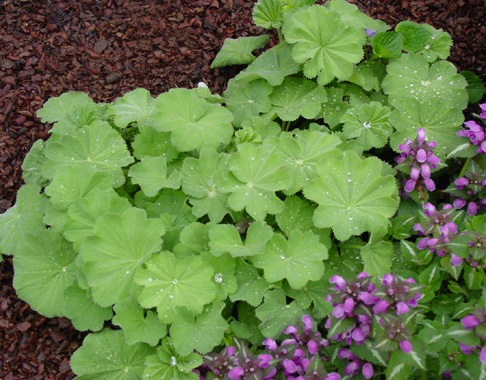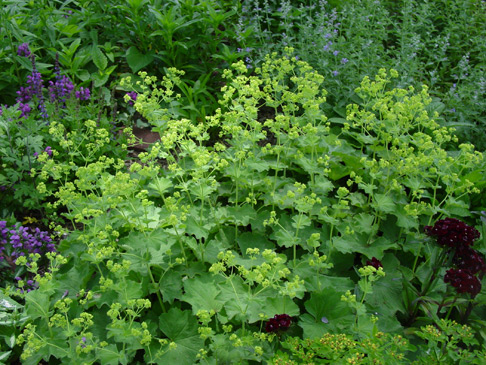Lady’s Mantle (Alchemilla mollisis) is familiar to experienced gardeners as a perennial herb that has some varieties growing to a height of 24 inches. With softly scalloped leaves and a bluish cast, alchemilla mollisis looks especially beautiful after a rain, when water droplets often cling the surface like so many pearls. In our area, Lady’s Mantle usually blooms in May & June with clouds of delicate yellow-green flowers that look a bit like chartreuse baby’s breath. These blooms work well as cut flowers, both in fresh and dried versions.
Lady’s Mantle is one of the easiest perennials to grow in our area. It doesn’t need any special conditions and thrives in most well-drained shady gardens. However it does best in areas with cool summers and doesn’t like to dry out. So, in Milwaukee, it is best to plant Lady’s Mantle in partial shade and water her when the weather heats up or she begins to droop. Adding a bit of compost and some mulch will also help her stay cool and moist. This plant is extremely cold-hardy and spreads slowly in clumps and can be used as a ground cover.
Gardening Tips
Lady’s Mantle naturalizes easily by dropping seeds, so you will need to keep it dead-headed to prevent plants appearing where they are not wanted. You will also want to occasionally tidy up your plant by removing older leaves as they brown.
Note: Since Lady’s Mantle is semi-evergreen, she will survive winter in better condition if left standing in fall and cleaned up in spring.
Research
Ladies Mantle root is edible, as are the leaves, which sheep and cattle are said to relish. The entire plant is normally harvested in midsummer and can be used medicinally for bruises and wound healing. Lady’s Mantle tea is said to be helpful for excessive menstruation.
I was not aware of these uses for Lady’s Mantle and found it is interesting that this beautiful plant is edible.






Mine comes up even in the lawn which is not a bad thing, just interesting.